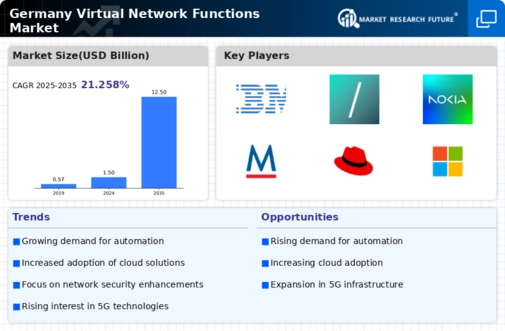The virtual network-functions market in Germany is characterized by a dynamic competitive landscape, driven by rapid technological advancements and increasing demand for digital transformation. Key players such as Cisco Systems (US), VMware (US), and Nokia (FI) are strategically positioned to leverage their extensive portfolios and innovative capabilities. Cisco Systems (US) focuses on enhancing its cloud-native solutions, while VMware (US) emphasizes its partnerships with telecom operators to facilitate seamless integration of virtual network functions. Nokia (FI), on the other hand, is investing heavily in 5G technologies, which positions it favorably in a market that increasingly prioritizes high-speed connectivity and network efficiency. Collectively, these strategies contribute to a competitive environment that is both collaborative and competitive, as companies seek to differentiate themselves through innovation and strategic partnerships.
In terms of business tactics, companies are increasingly localizing manufacturing and optimizing supply chains to enhance operational efficiency. The market structure appears moderately fragmented, with several key players holding substantial market shares. This fragmentation allows for a diverse range of offerings, yet the influence of major companies remains significant, as they set industry standards and drive technological advancements. The collective actions of these players shape the market dynamics, fostering an environment where innovation is paramount.
In October 2025, Cisco Systems (US) announced a strategic partnership with a leading German telecommunications provider to co-develop next-generation virtual network solutions. This collaboration is expected to enhance Cisco's market presence in Germany, allowing it to tap into local expertise and accelerate the deployment of its innovative technologies. The strategic importance of this partnership lies in its potential to create tailored solutions that meet the specific needs of the German market, thereby strengthening Cisco's competitive position.
In September 2025, VMware (US) launched a new initiative aimed at integrating AI capabilities into its virtual network functions. This move is indicative of VMware's commitment to staying at the forefront of technological innovation. By incorporating AI, VMware aims to enhance network automation and improve operational efficiencies for its clients. This strategic action not only reinforces VMware's competitive edge but also aligns with the broader industry trend towards AI integration in network management.
In August 2025, Nokia (FI) unveiled its latest 5G virtual network function, designed to optimize network performance and reduce latency. This development is crucial as it addresses the growing demand for high-speed connectivity in various sectors, including IoT and smart cities. Nokia's focus on 5G technology positions it as a leader in the market, potentially attracting new clients seeking advanced network solutions.
As of November 2025, current competitive trends in the virtual network-functions market are heavily influenced by digitalization, sustainability, and the integration of AI technologies. Strategic alliances are increasingly shaping the landscape, as companies recognize the value of collaboration in driving innovation. Looking ahead, competitive differentiation is likely to evolve, with a shift from price-based competition to a focus on technological innovation and supply chain reliability. This transition underscores the importance of agility and responsiveness in meeting the evolving demands of the market.

















Leave a Comment